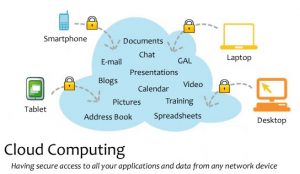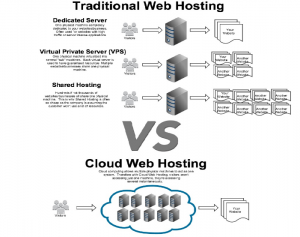Cloud hosting – Managed or traditional?

22 Jul 2020
When one thinks of the “cloud”, images of fluffy cotton balls in the sky are conjured up encouraging whimsical dreams of bright sunny days and shapes in the sky. Well at least for me.
This is swiftly followed by the logical and practical voice in my head saying “Not that cloud, the cloud, cloud”. Of course we all know what the cloud is. Sort of. To me, it is a magical place up in the sky (somewhere) that stores all of our valuable data and information that can be accessed from any of our mobile devices. It’s where your pictures go when you “upload to the cloud”. At least, I think so…
In reality, you have all used the cloud more often than you think. Media sharing services like Flickr, Instagram and YouTube, use the cloud. Webmail clients like Gmail and Hotmail also store info on the cloud. This explains why you are sometimes forced to purchase more storage space for your Gmail or Hotmail accounts. It provides you with more “space” on the cloud. Your banking apps, those also use the cloud for storage. So, you have used the cloud more than once. Knowingly or not.
But what is the cloud?
To cloud or not to cloud – that is not the question!
The legal industry, as we have said before, is very slow to change. Relying on their accepted status quo and clinging to their on-site windows installations and (almost) backward thinking when it comes to technological applications. The legal profession needs to embrace technology and the most obvious and readily available way to do this is through the cloud. This article is not to convince you to use the cloud. That should be a given. This article is to guide you on the basics of what the cloud entails, how it works and what solutions are available out there.
Let’s get to it.
Firstly, what actually is the cloud?
Where to even start ?
The first thing you need to know about the “cloud” is that it exists in remote data centres, like Teraco, which are accessed via the web. Essentially, it is a collection of networked computer hardware that work together to provide aspects of computing, but only online. The simplest example is using Dropbox and iCloud to store photos, email, music, calendars, contacts and other data in a central location, accessible from whatever device you happen to be using. It really is a little magical – you can’t physically touch the hardware itself or even see it, but you can control it remotely via web interfaces.
Given the lack of physical space, companies are looking to the digital world as the answer to storing “big data” (which is paramount). Having a “place” to store data that is both secure and easily accessible by companies is absolutely key.
However, the cloud is also a little more complicated than that. There are terms like “cloud storage” and “cloud computing”, which some may consider to be one and the same thing (like me) but that is not the case. And to further understand what both managed and traditional hosting entails, one needs to understand the basic concepts of storage vs computing first.
Cloud storage vs cloud computing
Cloud Storage
When I think about cloud storage, I imagine the act of storing files, on a remote server to be retrieved from multiple devices any time I need them. Cloud storage is simply a system that allows you to store data on the web, as you would save it on a computer. But remotely. Whether you’re talking about Google Drive, DropBox, or iCloud, the definition of cloud storage remains the same. It enables you to upload data to cloud-based servers. Once you have stored your data on the cloud, you, or any other person you give access to, can access it from multiple devices. It helps in preserving your important documents and files whilst at the same time giving you a better opportunity to collaborate on a project with other people through data sharing.
Cloud Computing
Cloud computing, whilst also involving users connecting to remote computing infrastructure via a network, is more often used to work on and complete specified projects. This infrastructure includes shared processing power, software and other resources. Cloud computing is linked to cloud storage in that you have to move data to the cloud (cloud storage) before you can make use of cloud computing systems. Once the data is moved to the cloud, it can be processed and used accordingly by authorised users.
How does the cloud work, especially for companies?
According to a study titled 31+ Cloud Computing Statistics, “90% of companies use some type of cloud service. Additionally, 60% of the workload will be run by a hosted cloud service. According to Forbes, more than 70% of CFOs exclaimed that cloud computing technology had a groundbreaking impact on their business”.
Those are astonishing statistics. They also evidence a growing interest and need for cloud services and a stronger reliance on the cloud as a viable and reliable online system. It therefore makes sense that companies have made moving to the cloud a priority to implement into their business dealings.
The question now comes down to deciding between traditional hosting or managed hosting and what the best cloud service for your firm is.
Managed hosting vs Traditional Hosting
Traditional hosting
In unmanaged or traditional hosting, you simply rent a server from the hosting provider but remain solely responsible for all the various services and maintenance tasks. Essentially, traditional hosting comes in two different forms – dedicated and shared.
Dedicated hosting, involves a company paying for the complete resources of one or more servers from a particular service provider. Once the client has paid a set amount for the resource they then have a set amount of dedicated bandwidth, CPU, RAM, and drive space. The bonus being that the client has full control over the server’s resources.
Shared hosting is the most cost efficient type of hosting. With shared hosting (more common among small and medium sized businesses), the client pays for a set amount of storage space and processing power which exists on a single server and that server’s resources are shared by a number of other clients – sort of like living in a “digs” back in the day. It’s a cost-efficient, low-maintenance way to host a website or application. The hosting company would then only be responsible for managing, maintaining, and updating the units. However, because resources are shared amongst a number of systems, as more users come on board it causes a decrease in performance of your own system. Essentially it comes down to a traffic problem – think of Witkoppen Road on a Friday afternoon during peak hour traffic. And the traffic lights are out. If the server (or traffic light in this example) experiences technical problems, everyone hosted on that server will be stuck in very bad traffic.
Managed hosting
In managed hosting, a service provider will lease web servers and associated hardware (on an on-demand and as-needed basis) and manage those systems on your behalf. It is the process of outsourcing a company’s computing and storage resources to a service provider that offers its infrastructure services as a utility model – sort of like having a property manager that’s taking care of everything for you. But here the user pays as they go for what they actually use. In the simplest terms, managed hosting means that the provider takes care of all your server related issues. You not only rent the server from the host, but you also pay them for managing it. It’s similar to getting a full warranty with free oil changes and maintenance when buying a new car.
You can take an alternative route and avoid Witkoppen altogether. Take the managed hosting route.
And what are the benefits of managed hosting for companies?
Companies using a managed hosting service get data protection benefits such as high availability and disaster recovery. Servers are also constantly and critically monitored for any irregularities or potential failures (hosting providers are well equipped with various tools and have tons of experience dealing with server security related issues). They constantly scan the operating system and core application to find security vulnerabilities, which they can fix in order to prevent the server from being attacked. Running security audits like spam filtering, virus scanning, software firewall configuration and OS updates is an invaluable tool in your “prevention is better than cure” arsenal.
It’s good to have back up, wouldn’t you say?
But what does this all cost ?
To help with the decision of choosing between a managed hosting service and a traditional hosting service, it comes down to auditing your current costs – from an infrastructure to a shared costs and day-to-day operational costs point of view. A good checklist would be to include hardware, support and maintenance agreements, software and licensing, staff resources to manage the infrastructure (including shared resource time from other teams, insurance for the hardware components, upgrades, downtime costs and allocations for disaster recovery), overheads such as power, cooling, security, fire suppression and environment control, and any associated support contracts, the costs of electricity consumption and rent. This list will assist you to build a holistic picture of the business’ infrastructure costs.
With traditional unmanaged hosting services, there are costs related to monthly salary expenditure to hire system admins, database admins, developers, and other staff to manage the servers, payment for hardware upgrades, which are constantly required (cue the Microsoft upgrade scenarios), the cash outlay for the day-to-day maintenance of the systems and most importantly the ever increasing and costly monthly insurance fees in case something goes awry leading to a systems crash. Basically everything that is included in the checklist audit.
But with managed hosting services, the providers are equipped with people who have the skills to handle any type of issue that a traditional hosting system requires extra cash outlay for. You won’t have to pay for additional costs and can invest the money you save into customer relationships.
There you have it. I would like to think that the choice between a managed and traditional hosting service is a no brainer. Do the costs of managed hosting outweigh the costs of traditional unmanaged hosting? Simply put – yes. There is far less that the business has to worry about and focus can be on real business.
But before we conclude, there is one more important consideration – if your software provider has a hosting service it makes sense to obtain your software and host from the same place. It is not only efficient but cost effective too. For example you are able to host the AJS system with the AJS hosting service or your Xpressdox system within the Xpressdox data centre as you would host your Microsoft apps with MS AZURE. Essentially one vendor for two operations. From a support, upgrade and peace of mind point of view, again it just makes good business sense.
See also:
- Data privacy and security under the spotlight
- The future of law is technologically driven
- Customised Monitoring Services – Reduce costs for your business
- Legal accounting and practice management
- The hackability of your cyber security password: Great minds think alike, fools seldom differ






